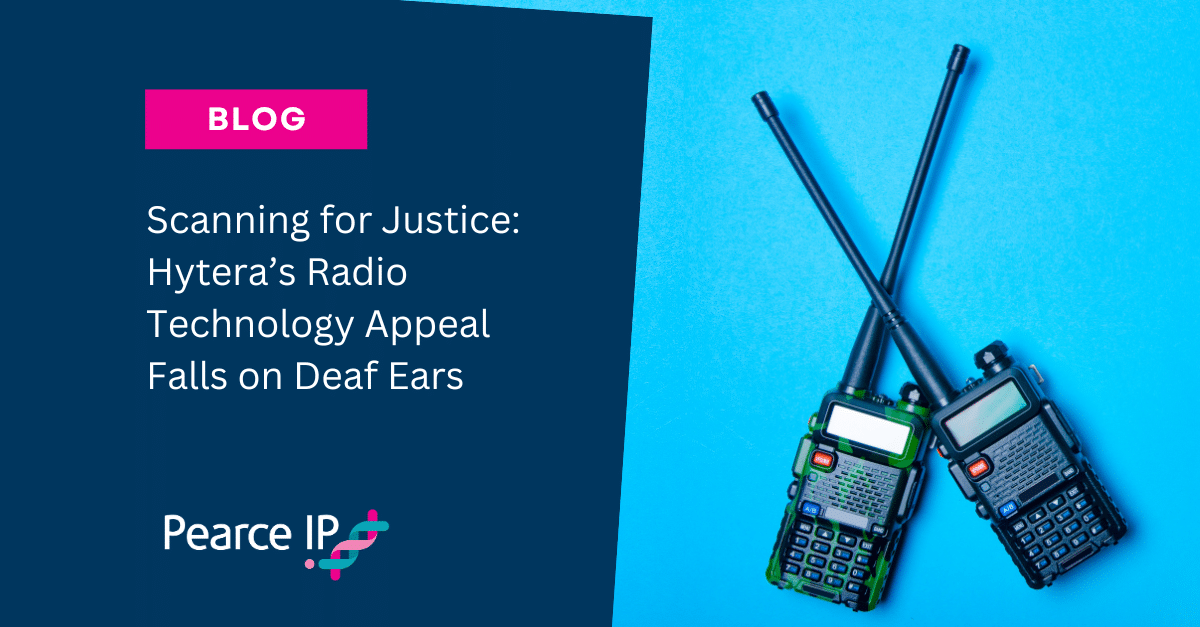| Date of decision: | 18 December 2024 |
| Body: | Full Court of the Federal Court |
| Adjudicator: | Justices Beach, O’Bryan and Rofe |
Introduction
The Full Court of the Federal Court has delivered judgment in the proceedings between Motorola Solutions Inc (Motorola) and Hytera Communications Corporation Ltd (Hytera), in their ongoing dispute concerning patents relating to digital mobile radio (DMR) technology. The Full Court upheld the primary judge’s patent findings, including that Hytera infringed one of Motorola’s patents, providing valuable guidance on construction and validity challenges – particularly around inventive step, utility and manner of manufacture.
The Full Court also addressed both parties’ appeal and contention points on the copyright case. We have not analysed the Full Court’s findings on the copyright case in this article.
Background
The case concerns DMRs, which are digital two-way radio devices that can transmit and receive signals from other radio devices operating on the same radio frequency. These devices are often used with base stations (repeaters) to extend their communication range and are primarily designed for group call communications in sectors like government, industry and emergency services.
The relevant patents relate to Time Division Multiple Access (TDMA) technology, which permits a frequency band within the radio spectrum (a channel) to be divided into timeslots so that more than one person may use the same channel at the same time. The relevant Motorola patents are as follows:
- AU2005275355 (the 355 Patent), relating to a method and system that improves the time taken to scan a TDMA channel to determine whether there is activity on that channel;
- AU2006276960 (the 960 Patent), relating to a method and system for accessing a de-keyed base station; and
- AU2009298764 (the 764 Patent), relating to a method for efficiently synchronising to a desired timeslot in a TDMA communication system.
In 2003, Motorola began working on a DMR project called ‘Matrix’. Motorola filed the relevant patents between 2005 and 2006, and subsequently launched its DMR devices in 2007. Hytera also pursued DMR technology from 2005, but encountered significant developmental hurdles and lagged significantly behind Motorola. In 2008, Hytera recruited a senior engineer from Motorola’s ‘Matrix’ project, who subsequently brought over 12 additional ex-Motorola engineers to Hytera. Hytera was subsequently able to bring their DMR product to market in 2010, and began distributing in Australia from 2013.
Motorola initiated proceedings in 2017, alleging both patent and copyright infringement. At first instance, the primary judge found that the ex-Motorola engineers took Motorola’s DMR source code to Hytera and utilised it in developing Hytera’s firmware, allowing it to launch its DMR product 18 months earlier than it would have otherwise.
On the question of patent infringement, the primary judge found that Hytera had infringed the 355 Patent before November 2019 (when Hytera reprogrammed its devices), but not the 764 Patent. The primary judge found the 960 Patent to be invalid for lack of inventive step.
Hytera appealed the infringement and validity findings against it on the 355 Patent, while Motorola cross-appealed the invalidity finding on the 960 Patent
Key Issues
355 Patent
Construction and Infringement
The 355 Patent aimed to reduce the time a subscriber unit (SU) spends scanning by providing a control message with ‘first information’ about channel activity and ‘second information’ about the activity’s characteristics.
Hytera’s challenge to the primary judge’s findings on infringement largely turned on questions of construction related to claim 1. Claim 1 claimed:
A method for scanning a TDMA channel by a subscriber unit in a wireless communications landscape, wherein the subscriber unit is operationally connected to at least one base radio over a plurality of channels, the method including the steps of:
[1] locking onto a channel of the plurality of channels by the subscriber unit wherein a subset of the plurality of channels is preprogrammed in a list in the subscriber unit;
[2] transmitting from at least one base radio a control message to the subscriber unit wherein the control message has a first information which informs the subscriber unit of activity present on the channel of the plurality of channels;
[3] receiving and decoding the control message for the first information by the subscriber unit; and
[4] if the first information indicates that activity is present on the channel of the plurality of channels, then
[5] determining whether the activity is of interest to the subscriber unit by comparing a second information in the control message with a third information preprogrammed in the subscriber unit and
[6] if the activity is of interest to the subscriber unit, then remaining on the channel of the plurality of channels to receive the activity present on the channel.
The parties specifically disagreed as to the construction of integers 5 and 6 and in particular about the meaning of the phrases:
- “determining whether the activity is of interest to the subscriber unit”; and
- “remaining on the channel … to receive the activity”.
Hytera argued that these integers required a single determination. If this determination was affirmative, the SU was then obligated to remain on the channel and receive the activity. On this interpretation, the method did not include the possibility that the determination of whether the activity was of interest to the SU might happen more than once. Motorola contended that this “determining” step was a provisional assessment, allowing for subsequent confirmatory steps.
The Full Court identified two distinct steps in claim 1. First, whether activity was present (first information). If the ‘first information’ did not indicate activity was present on the channel, the SU could move on to the next channel. If activity was present, the SU moved to the next step, comparing a ‘second information’ with pre-programmed ‘third information’. The Court observed that with ‘hashed IDs’ (compressed identifying information) as the ‘second information’, a positive match would stop scanning, but might require a further full ID check to confirm the activity was directed to that particular SU.
So, the Full Court agreed with Motorola’s construction that claim 1 did not exclude the possibility of further confirmatory steps, which aligned with both the invention’s function and the specification. In contrast, Hytera’s construction conflicted with the patent specification and claim 7, which presupposed that further steps may follow an initial determination.
On the question of infringement, Hytera challenged the primary judge’s finding that its supply of base stations constituted indirect infringement on the basis that the functionality defined by the claim was substantially implemented by the SU. The Full Court described this as a “distorted perspective”, holding that infringement clearly involved the combined use of the base stations and SUs, and that Hytera encouraged users to use base stations with SUs in circumstances where many end users would be using the “unreprogrammed” SUs (prior to Hytera taking steps in 2019 to reprogram the SUs).
Consequently, Hytera’s appeal against the primary judge’s finding of infringement of the 355 Patent was dismissed.
Inventive Step
Hytera contended that the method claimed by the 355 Patent lacked an inventive step in light of the common general knowledge (CGK), or alternatively, in light of the CGK with a 2004 document entitled “Draft Agenda Narrowband TDMA DMR Protocol” (the draft DMR protocol). The draft DMR protocol described a digital two-way radio system that implemented TDMA methods, which the primary judge found would have been ascertained by a skilled person tasked with designing a method for scanning in a digital two-radio system.
Despite finding that it was obvious to use a ‘first information’ to indicate the presence of activity, and to use a ‘second information’ of the kind which appeared in the full ‘link control’ message, the primary judge held that the claims were inventive because a person of ordinary skill would not have combined these elements as it would have led to a reduction in synchronisation patterns and forward error correction, which was inconsistent with the industry direction at the time. Further, his Honour posited that Mr. Kuhrt (Hytera’s expert) was “asked the wrong question”, as the question posed to him required an improvement in scan time without this being done in the context of the design of an overall system (which involved trading off competing design factors, such as control message and synchronisation pattern size, and forward error correction).
Hytera made a number of submissions challenging these findings as follows:
(i) the primary judge erred in considering that reduction in synchronisation patterns and forward error correction would have led the skilled person away from the invention when the claims made no stipulations about them;
(ii) the 2005 DMR Standard (which was based on the draft DMR protocol), and its publication shortly after the priority date, confirmed the solution was obvious and thus consistent with the industry direction;
(iii) the question posed to Mr. Kuhrt was appropriate since the scan time problem was acknowledged as CGK, and it was irrelevant that other aspects of DMR technology required further development;
(iv) Kuhrt’s revised methodology reflected an alternative approach he would have taken that met the requirements of the relevant claims;
(v) the primary judge erroneously considered Mr. Kuhrt’s evidence to be affected by hindsight; and
(vi) the evidence as a whole (including Motorola’s expert evidence) supported a finding that the claims lacked an inventive step.
The Full Court rejected these arguments. First, the Court agreed that it was not credible that Mr. Kuhrt could avoid hindsight bias given his exposure to the 2005 DMR Standard, and accepted the primary judge’s finding that his original proposed method of scanning would not have been compatible with existing standards.
Secondly, the Court upheld the assessment that Mr. Kuhrt’s revised methodology was “a very unlikely solution” at the priority date – solving the “relatively lesser problem of scan time” with a solution that degraded other aspects of system performance was possible but unlikely to be pursued.
Thirdly, the Court found that the task given to Mr. Kuhrt was artificial, as he understood it as creating “the ultimate scanning machine” without considering trade-offs.
Finally, the Court emphasised that Hytera’s approach impermissibly divided the invention into integers and then addressed whether each integer was itself obvious, rather than properly addressing the inventiveness of the combination.
Utility
Hytera argued that claim 1 could be implemented without regard to control message size, permitting implementations that would not improve scanning time. The Full Court rejected this challenge, noting that Hytera’s position did not reflect the evidence. Mr. Kuhrt had testified that implementing claim 1 in a way that would slow scanning would be “perverse” and “pointless”. The Court concluded that while claim 1 might technically encompass implementations that did not improve scanning time, these would not be reasonable implementations and were therefore not relevant to the utility assessment.
Manner of Manufacture
Hytera argued that the claimed invention was merely a scheme or set of directions rather than an “improvement in computer technology”. The primary judge rejected this argument, finding the invention was comparable to the “curve drawing algorithm” in International Business Machines Corporation v Commissioner of Patents (1991) 33 FCR 218, which involved improved computer programming by eliminating resource-intensive operations. The Full Court upheld this analysis, holding that the 355 Patent involved an improvement in communications technology through increased efficiency, which constituted patentable subject matter.
The 960 Patent
Inventive Step
The 960 Patent concerned a scenario where a base station would de-key if it determined no SUs were transmitting. The invention created a “temporary de-keyed state” during which the base station could receive and repeat transmissions with “proper synchronisation” without requiring the traditional wake-up process.
The primary judge found this invention to be obvious, characterising it as “the idea of allowing a de-keyed base station to receive out-of-synchronisation transmissions” with an inevitable timer to delimit this process.
On appeal, Motorola argued that:
(i) the primary judge improperly considered individual integers rather than the combination as whole;
(ii) the primary judge misunderstood the invention and the relevance of the “timing window”;
(iii) it was incorrect to state that no other solutions were possible;
(iv) Motorola’s expert, Professor Wicker, did not testify that the combination was obvious;
(v) the analysis did not address why the combination of integers was obvious; and
(vi) the primary judge confused the timer and timing window concepts.
The Full Court rejected these arguments, finding that the primary judge had properly determined that the combination of features claimed were “so obvious it went without saying”.
The Full Court noted that the problem of ignored transmission was known, both experts would have adopted a base station-focused solution, and the existence of alternative solutions did not avoid a finding of obviousness. While acknowledging some confusion by the primary judge between time and timing window concepts, the Full Court found this did not contaminate the ultimate conclusion reached by the primary judge, and that the Full Court would in any event have arrived at the same conclusion.
Construction and Other Challenges
A key dispute concerning the 960 Patent involved the meaning of “proper synchronisation” in claims 1 and 13. Hytera contended that the timing window for “proper synchronisation” could not be larger than 7.5 msec, arguing that a larger window would cause transmissions to overlap.
The Court rejected this construction, holding that “proper synchronisation” simply meant the transmission must be received within the timing window, with no specific limit imposed by the claims nor the specification. Hytera also cross-contended that the 960 Patent was not a manner of manufacture, but the Court rejected this argument for the same reasons given in respect of the 355 Patent.
Outcome
The Full Court held the 355 Patent to be valid and infringed by Hytera, and the 960 Patent invalid for lack of inventive step.
On costs, the Full Court deferred making a final determination but indicated that an appropriate allocation would be that Hytera pay 90% of Motorola’s costs of the appeals, reflecting that Hytera was wholly unsuccessful on its appeal, while Motorola was only partly successful in its cross-appeal (failing on the validity of the 960 Patent).
Implications
The Full Court’s judgment highlights some of the common pitfalls in invalidity arguments. The Court rejected Hytera’s reductive approach to the inventive step analysis that assessed individual integers rather than the claimed combination. Expert evidence was also scrutinised for hindsight bias, with the Court finding it implausible that knowledge of post-priority date technology could be entirely set aside. On utility, the decision confirmed that technically possible but “perverse” implementations would not invalidate a patent when a skilled reader would understand which implementations fulfil the intended purpose of the invention.
About Pearce IP
Pearce IP is a specialist firm offering intellectual property specialist lawyers and attorneys with a focus on the life sciences industries. Pearce IP and its leaders are ranked in every notable legal directory for legal, patent and trade mark excellence, including: Chambers & Partners, Legal 500, IAM Patent 1000, IAM Strategy 300, MIP IP Stars, Doyles Guide, WTR 1000, Best Lawyers, WIPR Leaders, 5 Star IP Lawyers, among others.
In 2025, Pearce IP was recognised by Australasian Lawyer and New Zealand Lawyer’s 5 Star Employer of Choice, and is the “Standout Winner” for inclusion and culture for firms with less than 100 employees. Pearce IP was awarded “IP Team of the Year” by Lawyers Weekly at the 2021 Australian Law Awards. Pearce IP is recognised by Managing IP as the only leading ANZ IP firm with a female founder, and is certified by WEConnect International as women owned.

Naomi Pearce
CEO, Executive Lawyer (AU, NZ), Patent Attorney (AU, NZ) & Trade Mark Attorney (AU)
Naomi is the founder of Pearce IP, and is one of Australia’s leading IP practitioners. Naomi is a market leading, strategic, commercially astute, patent lawyer, patent attorney and trade mark attorney, with over 25 years’ experience, and a background in molecular biology/biochemistry. Ranked in virtually every notable legal directory, highly regarded by peers and clients, with a background in molecular biology, Naomi is renown for her successful and elegant IP/legal strategies.
Among other awards, Naomi is ranked in Chambers, IAM Patent 1000, IAM Strategy 300, is a MIP “Patent Star”, and is recognised as a WIPR Leader for patents and trade marks. Naomi is the 2023 Lawyers Weekly “IP Partner of the Year”, the 2022 Lexology client choice award recipient for Life Sciences, the 2022 Asia Pacific Women in Business Law “Patent Lawyer of the Year” and the 2021 Lawyers Weekly Women in Law SME “Partner of the Year”. Naomi is the founder of Pearce IP, which commenced in 2017 and won 2021 “IP Team of the Year” at the Australian Law Awards.

Helen Macpherson
Executive, Lawyer (Head of Litigation –Australia)
Helen is a highly regarded intellectual property specialist and industry leader with more than 25 years’ experience advising on patents, plant breeder’s rights, trade marks, copyright and confidential information. She is known for her expertise in complex, high-value patent matters and leverages her technical background in biochemistry and molecular biology to work across a wide range of technologies, including inorganic, organic, physical and process chemistry, biochemistry, biotechnology (including genetics, molecular biology and virology), and physics. Helen is an active member of the Intellectual Property Committee of the Law Council of Australia and the Intellectual Property Society of Australia and New Zealand.

Nathan Kan
Lawyer
Nathan is a lawyer specialising in life sciences, providing legal advice and litigation support across intellectual property and commercial disputes. He is passionate about the intersection of law and science, and during his time with the Science and Technology Law Association at the University of Melbourne, he helped lead events, workshops and publications across STEM fields including life sciences, AI and digital transformation.

